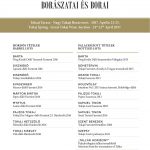István Szepsy is a charismatic winemaker. His vintage is 1951 and his childhood was spent in the vineyards as he went around with his father – the vineyards were like a playground to him. At the age of 17 he harvested the grapes from which the 1968 Aszú Eszencia came, grapes that were to become his eternal standard.
It is now 10th February 2017 and we are sitting talking in Tokaj. About vintages, vines, Furmint, clones and, naturally, the 5th Great Tokaj Wine Auction to be held in April. We know there will be a Szepsy Aszú. Those who don’t buy, who are only interested, – maybe love it – have the only chance to taste this lot destined to go under the hammer on the morning of April 22nd, at the pre-Auction blind tasting. What’s all the fuss about? Just because two years ago a barrel of his dry Furmint, Nyulászó 58, was sold for a record price? I don’t think so. A hammer price like this may give rise to many questions, but István accepts that Tokaji wines should be correctly positioned. We can’t expect others to treat Tokaj and the Carpathian Basin as their own. It is in our interests that the natural assets appear in the price of Tokaji wines, showing the potential for the wine region producers.
The Tokaji Wine Region has many great winemakers. Perhaps because here only be long-term thinking can work, so it sifts out the petty-minded speculators, knights of fortune…
It is true that there is no quick route to riches with vines. But Tokaj is experiencing a special period. We need to find our way back to the great Aszús; tradition must be linked with Furmint and top terroirs. The search and research can only be built on conclusive proof. Tasting a beautiful 150-year-old Aszú with its original label bought at auction does not give the key; it merely strengthens our suspicions that Tokaji Aszú is the best wine in the world. And this should be expressed in the price of the wine.
I asked István about his Auction lot.
“We plan to send a lot of our 2011 Aszú to the Auction. Unfortunately in recent years we did not have such a wine in our cellar that we were able to present, but now we are showing this Aszú lot. In almost every vintage after 2008, Botrytis was not the quality we would have liked. The Furmint skin thickens in the heat and then Botrytis does not show such a clear and defined character as, let’s say, in 1999. This was true in 2012 and to some extent in 2011 too. But we can still say 2011 is better as the vine did not suffer so much. Very beautifully silky wines were born with strongly shrivelled aszú berries, slow-forming Botrytis. Thick, creamy wine which is obviously still very young.”
My next question touched on the change in Aszú style that has been much discussed.
“Yes, we’re planning a great change in Aszú making too. We used to keep Aszús in the barrel for 5-6 years. These wines were beautiful and concentrated but we would like to make wines that are a little fruitier, livelier. And for this we definitely need to reduce the length of barrel aging. Longer barrel aging is good in some vintages but to retain the liveliness we have to take the Aszú out of wood earlier. If the raw material is good, then we have the balance anyway. Acids, sugar, good minerality makes wines long and complex. The quality of the aszú berry is supremely important. How ripe the grape is when the fungus attacks. This is the deciding factor as to how the wine will be.”
My own tasting experiences show that the wine practically explodes in the mouth. Its liveliness astounds. A faultless Aszú, its silkiness somewhat evokes certainly one of the best sweet wines in the world, the 199 Szepsy Cuvée.
“We are constantly trying with Furmint. Now we have enough experience in our own vineyards with the larger bunch clones that were selected after the war. Previously we thought that a serious wine could not be made from these, but now we have a couple of single-vineyards which are surprisingly beautiful with good structure, quite lively acidity and rich flavours. It’s important that we work with clones of the varieties that have loose bunches to avoid rot. Of course, the wine will be concentrated, but if rot sets in then it is very difficult to stop, so naturally the looser bunch clones are a little safer. We need to study the vines or we will not advance in quality. The route Tokaj producers must travel is that of continual improvement in quality. The only way to show uniqueness of the soils is through small parcels and distinct variety variations. This is how to create unique, unrepeatable and unparalleled wines. The same is true for Aszú making. A great Aszú can also show differences in spite of its serious sugar content. I truly believe in Furmint and that it shows its qualities in sweet wine too. But we still have work to do. We are progressing. Sometimes faster, sometimes slower, but always forward. The Auction is an important step on this route. It gives us exactly the real opportunity for us to show very small lots. We also have to learn what we can bring out of which vineyard. We must continuously show how far we have travelled. For this it is important that many come to the Auction, from Hungary and from abroad. That they taste the wines, visit the lands, the vineyards. This can give knowledge and experience. And us too.”
Gabriella Mészáros



